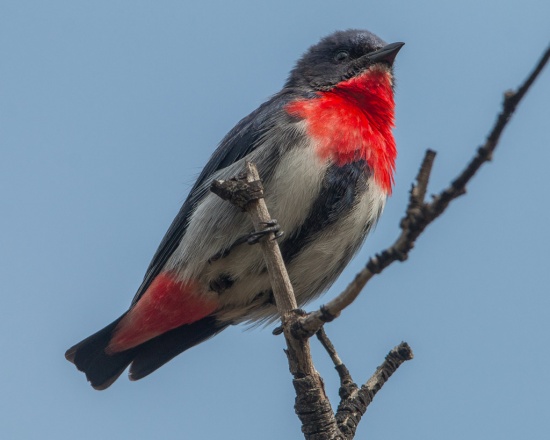m (Correction statement re-worded) |
m |
||
| Line 1: | Line 1: | ||
{{incomplete}} | {{incomplete}} | ||
| − | [[Image: | + | [[Image:824 Mistletoebird.jpg|thumb|550px|right|Photo by {{user|peterday|peterday}}<br />[[Windy Point Quarry, Adelaide]], [[South Australia]]]] |
;[[:Category:Dicaeum|Dicaeum]] hirundinaceum | ;[[:Category:Dicaeum|Dicaeum]] hirundinaceum | ||
==Identification== | ==Identification== | ||
Revision as of 11:48, 30 September 2015
| This article is incomplete. This article is missing one or more sections. You can help the BirdForum Opus by expanding it. |
- Dicaeum hirundinaceum
Identification
10-11cm
- Blueish-black plumage
- Red chest
- Red undertail
- White belly with black centre stripe
Female
- Dark grey upperparts
- Light grey belly
- Slight red tinge under the tail
Distribution
Australia, Papua New Guinea, and eastern Indonesia.
Taxonomy
Subspecies
There are 4 subspecies[1]:
- D. h. kiense:
- Southern Wallacea (Watubela, Tayandu and Kai islands)
- D. h. fulgidum:
- Tanimbar Island (Yamdena, Larat and Lutu)
- D. h. ignicolle:
- Aru Islands
- D. h. hirundinaceum:
- Islands in Torres Strait and treed areas of mainland Australia
Habitat
Trees and shrubs.
Behaviour
Diet
Diet includes the mistletoe berries, nectar, pollen, spiders, and insects.
Breeding
Both adults build the nest* of crushed plants, palm threads and spider webs.
*Most on-line sources state that only the female builds the nest, but this picture shows a male collecting nesting material from a palm.
References
- Clements, JF. 2011. The Clements Checklist of Birds of the World. 6th ed., with updates to August 2011. Ithaca: Cornell Univ. Press. ISBN 978-0801445019. Spreadsheet available at http://www.birds.cornell.edu/clementschecklist/downloadable-clements-checklist
- Wikipedia
- Wild Walks
- BF Member observations
Recommended Citation
- BirdForum Opus contributors. (2024) Mistletoebird. In: BirdForum, the forum for wild birds and birding. Retrieved 16 April 2024 from https://www.birdforum.net/opus/Mistletoebird




